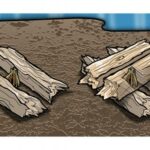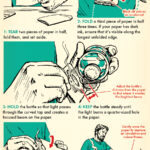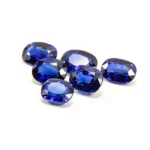Start Fire With Flint
1. Gather tinder: Find dry and easily combustible materials such as small twigs, dried leaves, grass, or thin strips of bark.
2. Prepare fire pit: Clear the area from any flammable objects or vegetation. Create a small pit or gather rocks to contain the fire.
3. Collect flint and steel: Locate a piece of flint rock and a steel striker, such as a pocket knife or a dedicated fire starter.
4. Position tinder: Arrange the tinder in a loose pile, ensuring it has enough air circulation for combustion.
5. Hold flint rock between your fingers in a comfortable grip.
6. Position the steel striker: Place the steel striker against the edge of the flint rock, perpendicular to it.
7. Aim sparks: Orient the striker downwards towards the tinder pile, with the sparks directed onto the tinder.
8. Strike the striker forcefully against the flint rock, aiming to generate sparks that fall onto the tinder. Repeat this action multiple times.
9. Watch for sparks: Look for glowing sparks landing on the tinder pile.
10. Blow gently: As soon as a spark ignites the tinder, gently blow on the ember to encourage its growth.
11. Nurture the ember: Continue to blow on the ember, providing oxygen to fuel the growing flame.
12. Gradually add more tinder: Once the ember starts growing, carefully add more tinder to create a larger flame.
13. Gradually add kindling: As the fire grows, place small twigs onto the flame to build up more heat.
14. Build a small teepee: Arrange larger sticks or logs in a teepee shape over the growing flame, allowing airflow for better combustion.
15. Monitor and tend to the fire: Keep a watchful eye on the fire, adjusting and adding more fuel as needed.
16. Be cautious with fire safety: Ensure the fire is contained within the fire pit and never leave it unattended.
17. Avoid windy conditions: Position yourself and the tinder pile to block the wind, preventing the sparks from being blown away.
18. Maintain appropriate distance: Keep your face and body a safe distance away from the tinder pile to avoid any injury from sparks.
19. Stay aware of surroundings: Ensure there are no flammable materials or structures nearby that can catch fire.
20. Be cautious with loose clothing: Avoid wearing loose clothing that may accidentally catch fire from sparks.
21. Exercise patience: It may take several attempts before successfully igniting the tinder, so don’t get discouraged.
22. Adapt your technique: Adjust the force and angle of the striker against the flint based on the results you observe.
23. Use char cloth or cotton balls: To increase the chances of ignition, you can use char cloth or cotton balls mixed with a flammable substance such as petroleum jelly.
24. Utilize fire starters: Consider using commercially available fire starters, such as magnesium rods or magnesium shavings mixed with tinder.
25. Seek assistance if needed: If you’re facing challenges or having difficulty starting the fire, ask for guidance from experienced individuals.
26. Maintain a safe environment: Ensure the fire is contained within a safe area, away from any potentially ignitable materials or vegetation.
27. Store flint and steel safely: Once you’ve successfully started a fire, store the flint rock and steel striker in a secure place.
28. Establish an emergency plan: Always have a plan in case the fire gets out of control, and know the location of the nearest water source or fire extinguisher.
29. Practice responsible fire management: Extinguish the fire completely by pouring water over it and ensuring all embers are fully extinguished before leaving the area.
30. Respect fire regulations: In specific areas or during certain times of the year, fire regulations may prohibit starting fires, so make sure to adhere to local laws and regulations.
More About Start Fire With Flint
Welcome to our blog, where we delve into the fascinating world of survival and emergency preparedness. Today, we are excited to explore an essential skill that has been practiced for centuries: starting a fire with flint. This ancient technique has long been used by our ancestors to provide warmth, cook meals, and signal for help in dire situations.
In a world full of modern conveniences, we often take for granted the ability to create fire with the simple click of a lighter or the strike of a match. However, imagine finding yourself in a remote location without access to these modern tools. Whether you are a seasoned adventurer, a nature enthusiast, or simply someone looking for practical knowledge, mastering the art of starting a fire with flint is an indispensable skill.
Flint, a hard, sedimentary rock composed mainly of silica, has been used by humans for thousands of years to create sparks. When struck against a sharp edge, such as a piece of steel, flint produces sparks that can ignite tinder, allowing us to kindle a fire. This seemingly basic process involves a precise technique, and understanding the properties of flint is the key to success.
One of the primary advantages of starting a fire with flint is its reliability in various environmental conditions. Unlike matches or lighters that can be rendered useless in wet or windy situations, flint remains a steadfast method for generating sparks. Even if you find yourself in a downpour or battling against gusts of wind, the mechanical force between the flint and steel can produce the necessary sparks to ignite your fire.
Another advantage of using flint is its longevity and reusability. Unlike matches or lighters that eventually run out, a well-maintained flint and steel set can serve you for an extended period. With proper care, the same flint can be used thousands of times, making it a practical and sustainable choice for long-term survival scenarios.
Moreover, learning to start a fire with flint allows us to reconnect with our ancestral roots and gain a deeper appreciation for the skills and knowledge our predecessors possessed. Imagine a time when early humans relied solely on their ability to create fire using rudimentary tools. By practicing this ancient technique, we rekindle the primal instincts and resourcefulness that have been ingrained in our DNA for centuries.
In addition to its practicality and historical significance, the art of starting a fire with flint can be a rewarding and enjoyable experience. As we master this age-old technique, we develop a deeper sense of self-sufficiency and a newfound confidence in our ability to survive in challenging situations. It serves as a reminder that we are capable of adapting to our surroundings, conquering adversity, and embracing the primal instincts that lie within us.
Whether you are an avid outdoor enthusiast, a curious learner, or someone seeking essential survival skills, the art of starting a fire with flint is a captivating subject. In our upcoming blog posts, we will delve into the intricacies of flint selection, the various techniques for striking sparks, and the different types of tinder you can use to fuel your fire. Join us as we embark on a journey to uncover the mysteries of this timeless survival skill, empowering ourselves with the knowledge and skills needed to thrive in the great outdoors.
Start Fire With Flint FAQs:
Q1: How does a flint work for starting a fire?
A1: When struck against steel, flint produces sparks, which can ignite a flammable material such as tinder.
Q2: What materials can I use as tinder when starting a fire with flint?
A2: You can use various materials such as dry leaves, small twigs, birch bark, or cotton balls soaked in petroleum jelly.
Q3: Can flint be used in wet conditions?
A3: Yes, flint can still produce sparks even in damp conditions, making it ideal for starting a fire in wet environments.
Q4: What should I look for when choosing a good piece of flint for fire-starting?
A4: Look for flint with sharp edges and a rough texture, as it will produce more sparks when struck against steel.
Q5: What type of steel can I use with flint to create sparks?
A5: Any high-carbon steel, such as the back of a knife, a ferrocerium rod, or a dedicated fire starter, can be used to strike against flint.
Q6: How do I strike flint properly to create enough sparks for a fire?
A6: Hold the flint firmly in one hand and strike it at a shallow angle against the steel, aiming for the point where the sparks can land on the tinder.
Q7: How many sparks can a flint produce with each strike?
A7: It varies, but a single strike of flint against steel can produce several hundred sparks, increasing the chances of igniting your tinder.
Q8: Can flint be a reliable method for starting fires?
A8: Yes, flint is a time-tested method for starting fires and has been used for centuries by survivalists, scouts, and outdoor enthusiasts.
Q9: Are there any safety precautions to consider when using flint?
A9: It’s important to exercise caution when striking flint, ensuring sparks are directed away from your body and any flammable material nearby.
Q10: Is it difficult to learn how to start a fire with flint?
A10: While it may take some practice to get the technique right, starting a fire with flint is a skill that can be learned relatively quickly with patience and persistence.


















